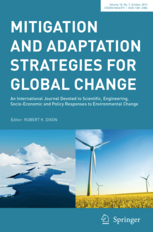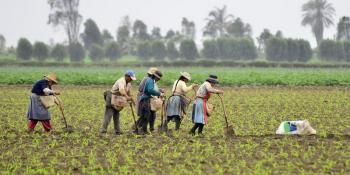Report identifies high-yield, low-emission options for cereal systems in South Asia

Transitioning to high-yield, low-emission cereal systems requires research and policies that focus on both agricultural technologies and socio-economic factors.
Increasing food demand of a growing population and changing consumption patterns are likely to cause a 30% increase in global greenhouse gas (GHG) emissions from agriculture by 2050. Asian and African countries will account for most of the increase.
Already, India is the third largest GHG emitter in the world, and agriculture is the second largest source of GHG emissions in the country, accounting for ~18% of gross national emissions. With a population of more than 1.3 billion and increasing, agricultural production is expected to increase significantly.
Given India's prominence, it is signficant that India recently declared a voluntary goal of reducing the emission intensity of its gross domestic product by 35% over the 2005 level by 2030. The government indicated that land-based mitigation measures are critical to achieving this target.
Recent research by the International Maize and Wheat Improvement Center (CIMMYT) and CCAFS published in the journal Mitigation and Adaptation Strategies for Global Change, shows that India’s goal of reducing emission intensity can be aligned with food security in a low emissions development scenario. In the figure below, the strong negative correlation between grain yield and emission intensity for rice, wheat and maize means that emission intensity can be reduced while farmers' yields increase.

The study identified high-yield, low-emission pathways for rice, wheat and maize production in the Indo-Gangetic Plains of India and calls for research and socio-economic interventions to support wide-scale adoption by smallholder farmers to meet food security and climate goals.
High-yield, low-emissions options for cereals
In cereals, the key determinants for agricultural emissions are rate, time and frequency of nitrogen fertilizer application, tillage practice (e.g. conventional or zero-tillage), application of manure and incorporation of crop residues. The study found that in the three main cereal crops of India - rice, wheat and maize - nitrous oxide (N2O) and methane (CH4) emissions increase with increased use of nitrogen inputs.
Eliminating nitrogen fertilizer inputs is not an option because it will cause yields – and thus household and national food security – to decrease precipitously. In India, the goal is that farmers scale back fertilizer use to optimum levels.
Researchers found that 82-95% farmers in a high-input production zone (Karnal, Haryana) and 23-40% farmers in the low-input production zone (Vaishali, Bihar) exceeded the optimum rate of application of nitrogen fertilizer in rice and wheat. This over-use of fertilizer indicates that India has a huge opportunity to reduce GHG emissions whilst maintaining production levels by reducing nitrogen fertilizer application rates to optimum levels and adopting fertilizer management practices that increase nutrient-use-efficiency.
In the case of rice production in the Karnal district of Haryana, research aimed to develop pathways for emission-efficient production and identify by how much different factors increase production and reduce emissions. Depending on production strategies and available resources, farmers have low-emission options immediately available to them. They can:
- Reduce emissions without compromising yield by reducing fertilizer amounts;
- Improve production with no additional emission by improving fertilizer-use efficiency; or
- Increase production and reduce emissions by layering multiple improved practices involving tillage, residue, nutrient and water management.
Socio-economic factors influence adoption of high-yield, low-emission agricultural practices
The study also examined how social drivers such as family size, gender, farm size, and use of information and communication technologies influence changes in practices in cereal production in India.
Researchers found strong associations between grain yield and emissions. Certain socio-economic and household characteristics suggest that efforts to decrease emission intensity in agriculture must focus on both agricultural technologies and socio-economic and human behavioural dimensions directly affecting their adoption. Te authors write:
Our analyses show that the implementation of emission-reducing technologies and practices are influenced by the household’s socio-economic conditions including family size, gender of household head and farm size, as well as access to information through training and use of ICT. These socio-economic factors must be taken into account when considering the scaling out of mitigation-related interventions and the implementation of high-yield low-emission pathways in agriculture. Future research evaluating a high-yield low-emission pathway in agriculture should consider not only emission-reducing interventions but also the tradeoffs between GHG emissions and food/nutrition security in different agricultural production systems.”
Capacity building to increase farmers’ awareness and skills in agriculture and climate change contributes to increased production and reduced GHG emission intensity. Thus, farmers’ societies, farm cooperatives and local non-governmental organizations can play a vital role in encouraging farmers to adopt high-yield, low-emission pathways.
Local to national adoption of high-yield, low-emission pathways for cereals
Reducing fertilizer input without compromising yield represents out-of-pocket financial savings on production for individual farmers, an important adoption incentive. Given current annual consumption of 16 million tonnes of nitrogen in India, small savings at the individual farmer level will lead to huge collective savings.
Additionally, decreasing the amount of wasted fertilizer helps reduce negative environmental externalities, such as water pollution, at local levels.
At a state and national level, policies that include multiple approaches to increasing farmers' awareness and access to information about climate-smart agricultural practices will be necessary to meet national targets for reductions in GHG emission intensity. Key approaches to reaching male and female farmers from a range of economic and educational backgrounds include: targeted subsidies, mobilization of local civil society organizations, and use of information and communication technologies.
Read more
- Sapkota TB, Aryal JP, Khatri-Chhetri A, Shirsath PB, Arumugam P, Stirling CM. 2017. Identifying high-yield low-emission pathways for the cereal production in South Asia. Mitigation and Adaptation Strategies for Global Change 1-21.
- CIMMYT blog: Study reveals new opportunities to cut greenhouse gas emissions in India
- CCAFS activities in South Asia and Low Emissions Development.
Tek Sapkota, an agricultural systems and climate change mitigation scientist at CIMMYT, is the lead author of the research paper and this blog. Julianna White, program manager for Low Emissions Development at CCAFS, edited the blog.




